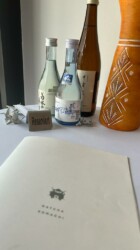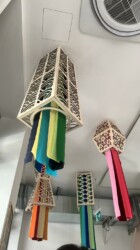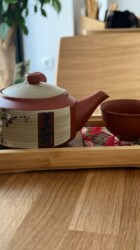
We can now finally eat with friends without much of a worry, and so we’re trying out the restaurants we’ve missed the past 2 years or so. We have often been to Matcha Komachi in Operngasse and we’ve always enjoyed their food. I can’t remember when they opened two other branches, but I’m glad we’re able to visit the one at Hoher Markt. Just like its sister restaurant, this branch maximizes space and can accommodate a number of people. There were smaller tables for those dining as a pair, and bigger ones for those dining as a group.
As I have stuck with my low-carb way of eating, I try to eat meat, seafood, green veggies and no rice (operating word: try). Since Matcha Komachi is a Japanese restaurant, it’s given that their main dishes would have mostly rice (don). I ordered the Unagi don (eel rice bowl) but requested to have rice replaced with salad instead and I got a side of seaweed salad too. My friend had a sushi boat, which I’m sure was satisfying.

Unagi no kabayaki
As a fish dish alone, eel is called Unagi no kabayaki. It is a popular Japanese dish that consists of grilled, skewered freshwater eel (unagi) glazed with a sweet and savory sauce. It is a traditional delicacy in Japanese cuisine and is often enjoyed during the summer months. To prepare unagi no kabayaki, the eel is first split down the belly, deboned, and butterflied. It is then grilled over a charcoal flame or broiled until it becomes tender and slightly crispy on the outside. During the grilling process, the eel is basted and brushed with a sauce called tare, which is typically made from soy sauce, mirin (a sweet rice wine), sugar, and sometimes sake. The sauce gives the eel a rich and flavorful glaze.
Unagi no kabayaki is often served over a bed of steamed rice (known as unadon or unaju) or alongside other side dishes such as pickles and miso soup. The combination of the tender, smoky eel with the sweet and savory sauce creates a delicious and satisfying taste experience.
In Japanese cuisine, eel is highly regarded for its unique flavor and texture. Unagi no kabayaki is considered a special dish and is commonly enjoyed on special occasions or as part of a celebratory meal.
I try to eat Eel when it’s available, although it’s a bit expensive so I can only have it once in a while.
Eel offers several potential health benefits due to its nutritional composition.
Here are some notable health benefits associated with consuming eel:
- Protein: Eel is a good source of high-quality protein, which is essential for building and repairing tissues, supporting muscle growth, and maintaining overall health.
- Omega-3 Fatty Acids: Eel contains omega-3 fatty acids, particularly EPA (eicosapentaenoic acid) and DHA (docosahexaenoic acid). Omega-3 fatty acids are known for their anti-inflammatory properties and potential benefits for heart health, brain function, and reducing the risk of chronic diseases.
- Minerals: Eel is a rich source of various minerals, including calcium, phosphorus, potassium, magnesium, and iron. These minerals play vital roles in maintaining bone health, regulating blood pressure, supporting muscle function, and contributing to overall physiological processes in the body.
- Vitamins: Eel contains several essential vitamins, such as vitamin A, vitamin E, and various B vitamins (including vitamin B12 and niacin). These vitamins are important for maintaining healthy skin, promoting immune function, supporting nerve health, and participating in energy metabolism.
Suffice to say, Matcha Komachi’s unagi no kabayaki is how it should be. Soft and juicy, and the marinade seeped through well to give it the taste that it should have. Eel tends to be bland, and the mixture of savory sauce gives its texture that yummy taste you’d look for in a fish dish. The salad with the strawberry went well with it too – tangy, pleasant combination.
Artistic Teapots
Now, we don’t only love the food, the overall interior is very simple but homey, and just have to mention the teapots the teas were served in. Japanese teapots, also known as kyusu or yokode kyusu, have a long history and are specifically designed for brewing tea. They are known for their elegant and artistic designs. They often feature intricate patterns (like the one we had), hand-painted motifs, or simple, minimalist aesthetics. The design of the teapot can enhance the overall tea-drinking experience and add a touch of beauty to the table.
Kyusu are commonly made from various materials such as cast iron, ceramic (porcelain or stoneware), clay (tokoname, banko, or shigaraki), or glass. Each material offers unique qualities that can affect the taste, temperature, and brewing characteristics of the tea. For example, clay teapots are believed to enhance the flavor and aroma of the tea over time. They are designed with practicality in mind. They often have a built-in handle for easy pouring and a spout with a fine sieve or filter to strain the tea leaves. This allows for precise control while pouring and ensures that only the brewed tea is served, while the leaves are retained within the pot.
Also, one cannot contend its heat retention. Certain materials used in Japanese teapots, such as cast iron or clay, are known for their heat retention properties. This helps to keep the brewed tea hot for a longer duration, allowing for multiple servings without losing flavor and warmth.
If you’d like to visit Matcha Komachi at Hoher Markt, look into their menu and decide early on what you’d have. Overall, Matcha Komachi at Hoher Markt is a good dining choice, we’ll surely come back for more.
--------------------------Book your Vienna stay here!--------------------------
















Leave a Reply